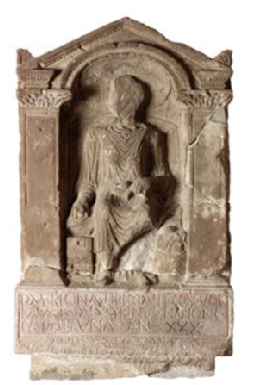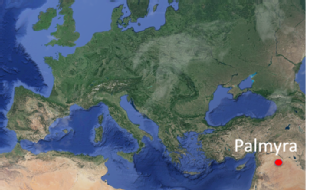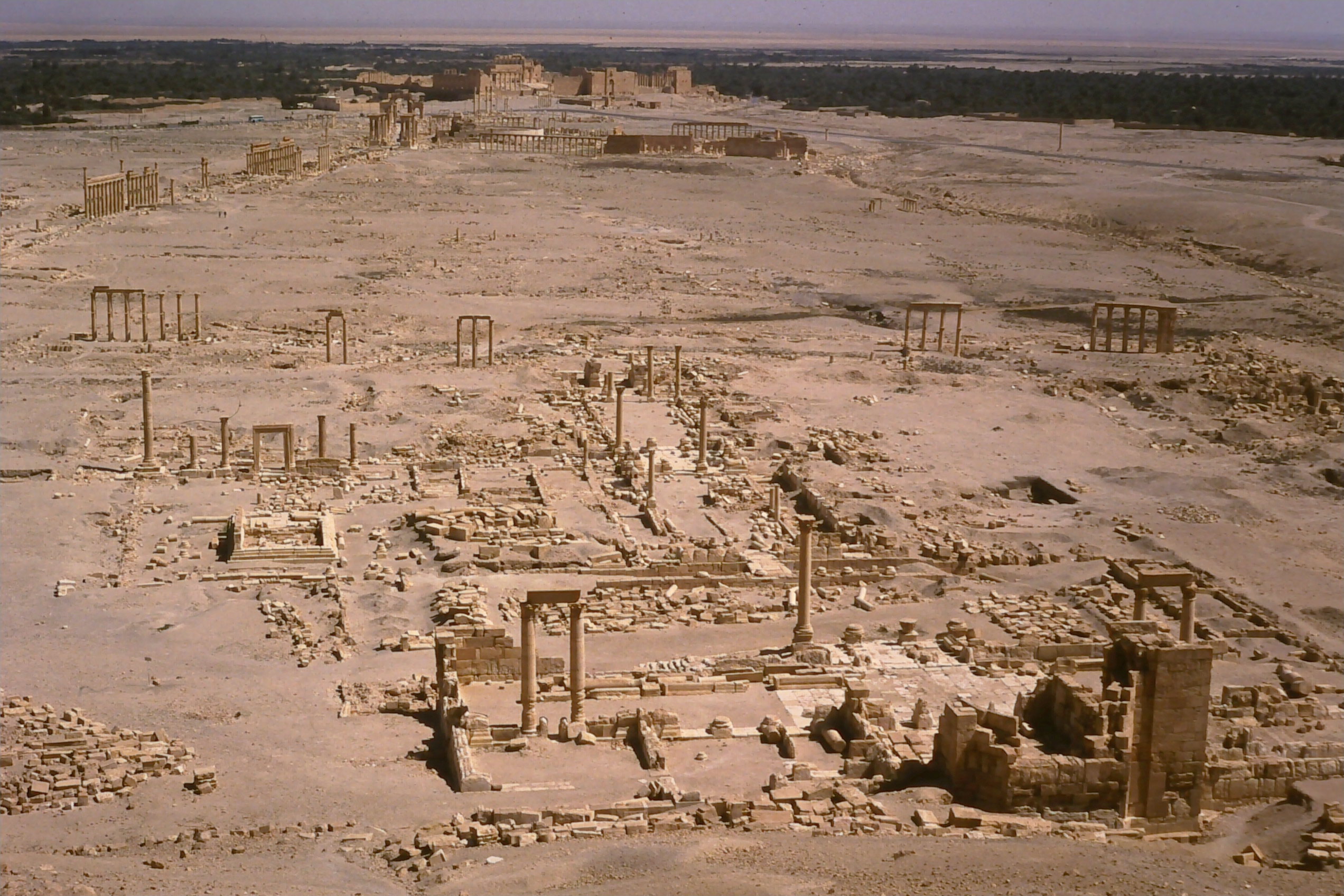Regina of Arbeia
Regina of Arbeia
 This rectangular sandstone tombstone (left) commemorates Regina of Arbeia.
This rectangular sandstone tombstone (left) commemorates Regina of Arbeia.
Unfortunately, it is damaged and her face is missing, and it was in 4 pieces which have been put together again.
It dates to the 2nd century CE and was found near the fort of Arbeia which is modern day South Shields, to the east of Newcastle upon Tyne. Arbeia was important as it guarded the main sea route to Hadrian’s Wall, so it was a key fort which also acted as a supply base. It is a UNESCO World Heritage Site and has reconstructions of Roman buildings as well as a large collection of finds in the museum.
Regina is depicted seated on a wicker chair inside a gabled niche, which is framed by two columns. She is wearing a long sleeved robe with a shorter tunic on top and she wears a necklace and bracelets. She is holding a distaff and spindle on her lap and at her left side is a work basket containing balls of wool. In her right hand she holds a jewellery box.
There are two replicas (casts) of the tombstone on display at other museums: The British Museum, in Gallery 49, and the Great North Museum at Hancock, Newcastle upon Tyne.
The inscription

 One of the really interesting and important things about this tombstone is that the epitaph for Regina is not only written in Latin, it also has a line of Palmyrene script as well, and this is unique in Roman Britain.
One of the really interesting and important things about this tombstone is that the epitaph for Regina is not only written in Latin, it also has a line of Palmyrene script as well, and this is unique in Roman Britain.
Palmyra was a very important and wealthy ancient city which is in modern day Syria as it was on the so-called “Silk Road” which was a network of trade routes connecting the east and the west.
There are 3 lines of Latin and 1 line of Palmyrene. These are translated as:
Latin: “To the spirits of the departed (and to) Regina, his freedwoman and wife, a Catuvellaunian by tribe, aged 30, Barates of Palmyra (set this up).”
Palmyrene: “Regina, the freedwoman of Barate, alas.”
On the Latin, you can see that the first two letters of the inscription “DM” don’t make a word. This is because in inscriptions (the study and interpretation of inscriptions is called epigraphy) a lot of words were abbreviated.
This was partly because both marble and carving on it was expensive, so inscriptions were carefully considered by the person setting them up as regards the cost and what they wanted to convey. By using standardised abbreviations, it allowed people to communicate messages through a type of code and although many people could not read they would have recognised certain letters together.
DM is an abbreviation of “dis manibus” and means “to the spirits of the departed”, and is a good example of an easily recognisable abbreviation. It came into use in the early first century CE and was used widely. The “Manes” were Roman protective deities who were linked to the spirits or souls of the dead.
Regina and Barates
So who were Regina and Barates and what can we tell about them from the tombstone and epitaph?
Who was Regina?
The inscription tells us quite a lot about her. She was a freedwoman, which means that she was a slave belonging to Barates before she married him. It is interesting that her name actually means “queen” – in fact providing a contrast between it and her previous status as a slave – quite ironic!
She was also a member of the Catevellaunian tribe, who occupied a large part of south- eastern England – today’s Bedfordshire, Buckinghamshire and Hertfordshire.
The last thing the inscription tells us is that she was aged 30 when she died: again this is an abbreviated formula used on tombstones – “AN” which stands for various grammatical forms of the Latin word “annus” meaning year. It was more important in Roman society to record how many years someone had lived rather than the actual year they died – different to the modern day where the year someone was born/died is usually recorded on gravestones.
What about Barates?
Again the inscription tells us that he was originally from Palmyra and again – like Diodora he has used his native language to include a line on the epitaph. So again this is likely due to him wanting to identify himself and be connected for posterity with his native land.

Above is a photo of Palmyra in Syria taken in 2002 by Dr Grigsby.
Thinking about the relationship between Regina and Barates, there are three interesting things to consider.
- Regina had been his slave and at some point he had freed her and then married her, so her status had changed.
- We can get a glimpse into their relationship given that the last word in the inscription “alas” hints at Barates’ grief at his loss of his wife, suggesting that their relationship may have been a happy one (or at least that is the opinion he gives of it!).
- Barates has commissioned an expensive tombstone full of detail to commemorate Regina. This could indicate the real affection he had for her, or may also have been a means to promote his own wealth and status too.
It may be interesting to think about what Regina’s life may have been like: was she happy leaving her tribe and moving north? Was she taken against her will as a slave? Did she willingly marry Barates?
Lastly here it is worth considering a couple of elements in terms of how Barates has portrayed Regina:
Firstly, the inclusion of objects related to spinning: the distaff, spindle, balls of wool and basket. In Roman society, spinning was almost exclusively related with women and their domestic role. The inclusion of these sort of objects on tombstones is fairly common and was intended to signify both female virtue and domestic skills. So Barates was trying to show that Regina was a good wife/woman.
It also seems that demonstrating her wealth/status was important, as she is portrayed wearing jewellery and with the jewellery box, as well as in more provincially-styled clothing which is not entirely Roman
The last thing here is to point out that Regina’s tombstone again demonstrates the multicultural nature of Roman Britain: it is a Roman styled funerary monument, commemorating a native British woman, set up by a Palmyrene man, with an inscription in both Latin and Palmyrene.
